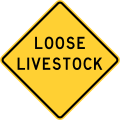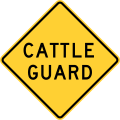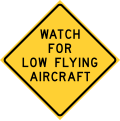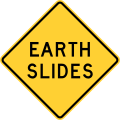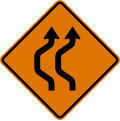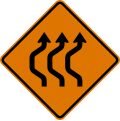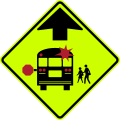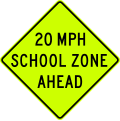Draft:Road signs in Texas
| Submission declined on 4 August 2024 by CFA (talk). The proposed article does not have sufficient content to require an article of its own, but it could be merged into the existing article at Road signs in the United States. Since anyone can edit Wikipedia, you are welcome to add that information yourself. Thank you.
Where to get help
How to improve a draft
You can also browse Wikipedia:Featured articles and Wikipedia:Good articles to find examples of Wikipedia's best writing on topics similar to your proposed article. Improving your odds of a speedy review To improve your odds of a faster review, tag your draft with relevant WikiProject tags using the button below. This will let reviewers know a new draft has been submitted in their area of interest. For instance, if you wrote about a female astronomer, you would want to add the Biography, Astronomy, and Women scientists tags. Editor resources
|  |
| Submission declined on 15 April 2024 by ToadetteEdit (talk). This submission is not adequately supported by reliable sources. Reliable sources are required so that information can be verified. If you need help with referencing, please see Referencing for beginners and Citing sources. Declined by ToadetteEdit 6 months ago. |  |
 Comment: It does not appear to be standard for individual states to get their own "Road signs in" article. Consider getting consensus on Talk:Road signs in the United States about splitting off before resubmitting. C F A 💬 17:52, 4 August 2024 (UTC)
Comment: It does not appear to be standard for individual states to get their own "Road signs in" article. Consider getting consensus on Talk:Road signs in the United States about splitting off before resubmitting. C F A 💬 17:52, 4 August 2024 (UTC)
 Comment: I'm afraid I don't think I'm the right person to evaluate this article, sadly. Sincerely, Guessitsavis (she/they) (Talk) 17:32, 17 March 2024 (UTC)
Comment: I'm afraid I don't think I'm the right person to evaluate this article, sadly. Sincerely, Guessitsavis (she/they) (Talk) 17:32, 17 March 2024 (UTC)
 Comment: For a few of these signs, they seem to come from Delaware. Is this because they are the same? Sincerely, Guessitsavis (she/they) (Talk) 21:34, 16 March 2024 (UTC)
Comment: For a few of these signs, they seem to come from Delaware. Is this because they are the same? Sincerely, Guessitsavis (she/they) (Talk) 21:34, 16 March 2024 (UTC)

Road signs in Texas are regulated in the Texas Manual on Uniform Traffic Control Devices (TMUTCD), the standard for traffic signs, road surface markings, and traffic signals in the U.S. state of Texas. It is developed by the Texas Department of Transportation "in substantial conformance to" the national Manual on Uniform Traffic Control Devices (MUTCD) developed by the Federal Highway Administration (FHWA).
Adoption and compliance
[edit]The 11th edition of the MUTCD was released on December 19, 2023 with an effective date of January 18, 2024.[1] Texas has two years from the effective date to adopt the new TMUTCD.[2]
The first edition of the Texas Manual on Uniform Traffic Control Devices was published in 1980.[3][4] This manual was most recently updated in 2014, after the revision 2 of the 2011 edition was released. Texas is among the ten states to have adopted its own MUTCD "in substantial conformance to" an edition of the national MUTCD, annotated throughout with state-specific modifications and clarifications.[5]
Regulatory signs
[edit]Regulatory signs give instructions to motorists, pedestrians, and cyclists. Signs including Stop, Yield, No Turns, No Trucks, No Parking, No Stopping, Minimum Speed, Right Turn Only, Do Not Enter, Weight Limit, and Speed Limit are considered regulatory signs. Some have special shapes, such as the octagon for the Stop sign and the crossbuck for railroad crossings. These signs are in the R series of signs in the MUTCD and typically in the R series in most state supplements or state MUTCDs.
R1 series: Stop and yield
[edit]The MUTCD's R1 series is for Stop and Yield. The 4-WAY and 3-WAY plaques (R1-3) were deprecated in the 2009 Edition of the MUTCD in favor of the ALL WAY plaque (R1-3P).
-
R1-1
Stop -
R1-2
Yield -
R1-2aP
To oncoming traffic (plaque) -
R1-2bTP
To ramp (plaque) -
R1-2cTP
To train (plaque) -
R1-3P
All way (plaque) -
R1-5
Yield here to pedestrians -
R1-5a
Yield here to pedestrians -
R1-9
Overhead pedestrian crossing[a] -
R1-10P
Except right turn (plaque)
R2 series: Speed limit
[edit]The MUTCD's R2 series is for speed limit signs. Some state supplements and state MUTCDs place various speed limit signs in other series. Speed limits in the United States are always in miles per hour.
-
R2-1
Speed limit -
R2-1T
Speed limit (with red border) -
R2-4P
Minimum speed limit (plaque) -
R2-4a
Combined speed limit -
R2-4cT
Maximum legal speeds -
R2-5P
Unless otherwise posted (plaque) -
R2-5aP
Citywide (plaque) -
R2-5bP
Neighborhood (plaque) -
R2-5cP
Residential (plaque)
R3 series: Lane usage and turns
[edit]The MUTCD's R3 series of signs is for lane usage and turn signs.
-
R3-1
No right turn -
R3-2
No left turn -
R3-3
No turns -
R3-4
No U-turn -
R3-5L
Left turn only -
R3-5R
Right turn only -
R3-5a
Straight through only -
R3-5b
Left lane (plaque) -
R3-5cP
HOV 2+ (plaque)[b] -
R3-5dP
Taxi lane (plaque) -
R3-5e
Center lane (plaque) -
R3-5f
Right lane (plaque) -
R3-5g
Bus lane (plaque) -
R3-6L
Optional movement lane control, straight through and left turn -
R3-6R
Optional movement lane control, straight through and right turn -
R3-8
Advance intersection lane control (two lanes) -
R3-8a
Advance intersection lane control (three lanes) -
R3-8b
Advance intersection lane control (three lanes) -
R3-8uT
Turnaround only -
R3-9a
Two-Way Left turn only (overhead) -
R3-9b
Two-Way Left turn only (post-mounted) -
R3-9cP
BEGIN -
R3-9dP
END -
R3-9e
Reversible lane control (symbol) -
R3-9f
Reversible lane control (post-mounted) -
R3-9g
Advance reversible lane control transition signing -
R3-9h
Advance reversible lane control transition signing -
R3-9i
End Reverse Lane -
R3-17
Bike lane -
R3-17aP
Ahead plaque -
R3-17bP
Ends plaque -
R3-18
No U or left turn -
R3-20L
Begin left turn lane -
R3-20R
Begin right turn lane -
R3-27
No straight through -
R3-33R
Right lane must exit -
R3-33L
Left lane must exit -
R3-33TR
Right lane must exit -
R3-33TL
Left lane must exit -
R3-33aTR
Right lane must enter ramp -
R3-33aTL
Left lane must enter ramp -
R3-33bTR
Right lane must enter freeway -
R3-33bTL
Left lane must enter freeway -
R3-33cT
All traffic must exit
R4 series: Regulation of movement
[edit]The MUTCD's R4 series of signs is for the regulation of movement signs. As all situations are not covered, several states have their own standards in addition to the MUTCD.
-
R4-1
Do not pass -
R4-2
Pass with care -
R4-2aT
Left lane for passing only -
R4-3
Slower traffic keep right -
R4-3bT
Do not cross double white line -
R4-4
Begin right turn lane yield to bikes -
R4-5aT
No trucks left lane -
R4-5bT
Begin no trucks left lane -
R4-5cT
End no trucks left lane -
R4-7
Keep right -
R4-7a
Keep right -
R4-7b
Keep right -
R4-7c
Keep right of obstacle -
R4-8
Keep left -
R4-8a
Keep left -
R4-8b
Keep left -
R4-8c
Keep left of obstacle -
R4-9
Stay in lane -
R4-10
Runaway vehicles only -
R4-12
Slow vehicles with five or more following vehicles must use turn-out -
R4-13
Slow vehicles must use turn-out ahead -
R4-14
Slow vehicles must turn out -
R4-17
Do not drive on shoulder -
R4-18
Do not pass on shoulder
R5 series: Exclusionary
[edit]The MUTCD's R5 series of signs is for exclusionary signs. The most common of these signs is the do not enter sign.
-
R5-1
Do not enter -
R5-1TP
Ramp (plaque) -
R5-1a
Wrong way -
R5-1b
Wrong way for bicycles -
R5-2
No trucks -
R5-3
No motorized vehicles -
R5-4
No commercial vehicles -
R5-4aT
No engine brake by city ordinance -
R5-5
No lugged vehicles -
R5-6
No bicycles -
R5-7
No non-motorized traffic -
R5-8
No motor driven cycles -
R5-10
No pedestrians, bicycles or motor driven cycles -
R5-10a
No pedestrians, bicycles or motor driven cycles on freeway -
R5-10b
No pedestrians or bicycles -
R5-10c
No pedestrians -
R5-11T
For official or emergency vehicle use only
R6 series: One way and divided highway
[edit]The MUTCD's R6 series of signs is for one way and divided highway signs. The most common of these signs is the One Way sign.
-
R6-1R
One way (right) -
R6-1L
One way (left) -
R6-2R
One way (with arrow) (right) -
R6-L
One way (with arrow) (left) -
R6-3
Divided highway crossing -
R6-3a
Divided highway crossing, T-intersection -
R6-4
Chevron roundabout directional -
R6-4a
Chevron roundabout (three chevrons) -
R6-4b
Chevron roundabout (four chevrons) -
R6-5P
Roundabout circulation (plaque) -
R6-6
Begin one way -
R6-7
End one way
R7 series: Parking
[edit]The MUTCD allows for three types of parking signs: permissive, No Parking, and No Standing. However, in most states, there is an additional more restrictive one, No Stopping. These signs are found in the R7 series of signs in the MUTCD. Permissive parking signs allow for parking for either an unlimited or varied amount of time. They are often used in conjunction with parking meters and parking permits. They are specified by the MUTCD to be green on white. Local variations occur with additional information and slightly different designs. No Parking signs indicate that loading or unloading while temporarily stopped is permitted, but the driver must not leave the vicinity of the vehicle.[6] Some No Parking signs display time restrictions, while others are permanent restrictions. There are also temporary versions of the signs, often of similar design to the permanent ones. These signs are specified by the MUTCD to be red on white, although local variations occur. No Standing signs indicate that stopping temporarily to load or unload passengers is allowed, but vehicles cannot be stopped at the location for longer periods of time, even if the driver remains with the vehicle.[6] As with no parking signs, some restrictions displayed on the signs are permanent, and some are time-based.
-
R7-1
No parking any time -
R7-2
No parking from 8:30 am to 5:30 pm -
R7-2a
No parking from 8:30 am to 5:30 pm (alternative) -
R7-3
No parking except Sundays and Holidays -
R7-4
No standing any time -
R7-5
One hour parking time -
R7-6
No parking, loading zone -
R7-7
No parking bus stop -
R7-8
Reserved parking (wheelchair) -
R7-8aP
Van accessible -
R7-8aPT
Violators subject to fine and towing (plaque) -
R7-9
No parking bike lane -
R7-9a
(No parking symbol) bike lane -
R7-11
Parallel parking (double) -
R7-20
Parking fee station -
R7-21R
1 hour pay parking -
R7-21aR
Pay parking 15 minute limit -
R7-22
Pay parking -
R7-23
Permitted parking from 8:30 am to 5:30 pm -
R7-23a
Permitted parking 1 hour from 7:00 am to 6:00 pm -
R7-107
No parking, bus stop -
R7-107a
No parking, bus stop -
R7-108
Two hour parking time from 8:30 am to 5:30 pm -
R7-111
No parking except electric vehicles -
R7-111a
No parking except electric vehicles -
R7-112
2 hr parking electric vehicles only -
R7-112a
2 hr parking electric vehicles only -
R7-112b
2 hr parking electric vehicles only -
R7-113
2 hr parking exempt while charging (with arrow) -
R7-113aP
Vehicle must be plugged in (plaque) -
R7-113bP
Vacate stall when charging completed (plaque) -
R7-114
2 hr vehicles charging only -
R7-114a
45 min vehicle charging only -
R7-114b
45 min vehicle charging only -
R7-200
No parking and one hour parking time (combined horizontal) -
R7-200a
No parking and one hour parking time (combined vertical) -
R7-201P
Tow away zone -
R7-201aP
Tow away zone (plaque, red) -
R7-202P
This side of sign (plaque, red) -
R7-202aTP (RED)
Between signs (plaque, red) -
R7-202aTP (GRN)
Between signs (plaque, green) -
R7-202bTP (GRN)
Here to corner (plaque, green) -
R7-202bTP (RED)
Here to corner (plaque, red) -
R7-203
Emergency snow route
R8 series: Parking and emergency restrictions
[edit]The MUTCD's R8 series of signs is for parking restriction and emergency restriction signs.
-
R8-1
No parking on pavement -
R8-1aT
No parking on bridge -
R8-1bT
No parking on row -
R8-1cT
No parking on tracks -
R8-1dT
No parking on shoulder -
R8-2
No parking except on shoulder -
R8-2T
No parking within 10 feet of pavement -
R8-3
No parking -
R8-3aTDBL
No parking (double) -
R8-3aTR
No parking (left) -
R8-3aTL
No parking (right) -
R8-3bP
Exception of Sundays and holidays -
R8-3gP
Loading zone -
R8-3iTP
On shoulder -
R8-3kT
No truck parking -
R8-4
Emergency parking only -
R8-5
No stopping on pavement -
R8-6
No stopping except on shoulder -
R8-7
Emergency stopping only -
R8-8
Do not stop on tracks -
R8-9
Tracks out of service -
R8-10
Stop here when flashing -
R8-10a
Stop here when flashing
R9 series: Bicycles and pedestrians
[edit]The MUTCD's R9 series of signs is for bicycle and pedestrian signs.
-
R9-1
Walk on left facing traffic -
R9-2
Cross only at cross walks -
R9-3
No pedestrians crossing (symbol) -
R9-3a
No pedestrians crossing -
R9-3b
Use crosswalk (plaque) -
R9-4
No hitchhiking (symbol) -
R9-4a
No hitchhiking -
R9-5
Use ped signal -
R9-5
Yield to peds -
R9-7
Bicycles left pedestrians right -
R9-8
Pedestrian crosswalk -
R9-9
Sidewalk closed -
R9-10
Sidewalk closed, use other side -
R9-11
Use other side ahead, cross here -
R9-11a
Sidewalk closed, cross here -
R9-13
No skaters -
R9-14
No equestrians
R10 series: Traffic signal
[edit]The MUTCD's R10 series of signs is for traffic signal related signs.
-
R10-1
Cross only on green -
R10-2
Cross only on pedestrian signal -
R10-3
Push button for walk signal -
R10-3a
Push button to cross street, wait for pedestrian signal -
R10-3b
Crosswalk signal instructions -
R10-3c
Crosswalk signal instructions -
R10-3d
Crosswalk signal instructions -
R10-3e
Crosswalk signal instructions -
R10-3f
Crosswalk signal instructions -
R10-3g
Crosswalk signal instructions -
R10-3h
Crosswalk signal instructions -
R10-3i
Crosswalk signal instructions -
R10-4
Push button for green -
R10-4a
Push button to cross street, wait for green -
R10-4b
Pedestrian signal -
R10-5
Left on green arrow only -
R10-6
Stop here on red -
R10-6a
Stop here on red (alternate) -
R10-7
Do not block intersection -
R10-8
Use lane with green arrow -
R10-9T
Protected left on green arrow -
R10-10L
Left turn signal -
R10-10R
Right turn signal -
R10-11
No turn on red -
R10-11a
No turn on circular red -
R10-11T
No right turn on red -
R10-12
Left turn yield on green -
R10-12a
Left turn yield on flashing yellow arrow -
R10-12b
Left turn yield to bicycle -
R10-13
Emergency signal -
R10-14T
Emergency signal - stop when flashing red -
R10-14aT
Emergency signal - stop when flashing red -
R10-14b
Stop here on flashing red -
R10-15
Turning vehicles yield to pedestrians -
R10-15a
Turning vehicles stop to pedestrians -
R10-16
U-turn yield to right turn -
R10-17T
Left turn yield on flashing yellow arrow -
R10-17a
Right on red arrow after stop -
R10-18a
Traffic signal photo enforced -
R10-20aP
Days & times (plaque) (for use with R10-11 series) (2 lines) -
R10-20aP
Days & times (plaque) (for use with R10-11 series) (3 lines) -
R10-22
Bicycles to request green wait on line -
R10-23
Crosswalk - stop on red -
R10-25
Push button to turn on warning lights -
R10-26
Push button for green light -
R10-27
Left turn yield on flashing red arrow after stop -
R10-28
XX vehicles per green -
R10-29
XX vehicles per green each lane -
R10-30
Right turn on red must yield to U-turn -
R10-31P
At signal (plaque) -
R10-32P
Push button for 2 seconds for extra crossing time
R11 series: Road closed
[edit]The MUTCD's R11 series of signs is for road closure-related signs.
-
R11-1
Keep off median -
R11-2
Road closed -
R11-2aT
Bridge closed -
R11-2bT
Ramp closed -
R11-2cT
Street ramp closed -
R11-2c
Path closed -
R11-3
Road closed XX miles ahead, local traffic only -
R11-3a
Street closed XX miles ahead, local traffic only -
R11-3b
Bridge out XX miles ahead, local traffic only -
R11-4
Road closed to thru traffic -
R11-5aT
High water road closed (folding sign) -
R11-5bT
High water road closed when flashing
R12 series: Weight limits
[edit]The MUTCD's R12 series of signs is for weight limit-related signs.
-
R12-1T
Weight limit -
R12-2
Axle weight limit -
R12-2bT
Weight limit, axle or tandem XX lbs -
R12-2cT
Weight limit, tandem axle XX lbs -
R12-3
Truck weight limit -
R12-4
Weight limit with per axle and gross -
R12-4aT
Weight limit, axle XX lbs, tandem XX lbs -
R12-4bT
Weight limit, gross XX lbs, axle or tandem XX lbs -
R12-4cT
Weight limit, gross XX lbs, tandem axle XX lbs -
R12-8aT
Weight limit -
R12-8bT
Weight limit -
R12-8cT
Weight limit -
R12-9T
Width limit 8 feet -
R12-9aT
Width limit 8 ft 6 in
R13 series: Weigh stations
[edit]The MUTCD's R13 series of signs is for weigh station related signs.
-
R13-1T
All commercial vehicles & buses next right when flashing -
R13-1TPR
All trucks next right -
R13-1TPL
All trucks next left -
R13-1aT
All trucks must stop ahead (folding sign) -
R13-1bT
Trucks-buses must stop ahead (folding sign) -
R13-1cT
All trucks next right when flashing -
R13-2T
All vehicles must stop ahead when flashing -
R13-3T
Use low beams -
R13-7T
Livestock poultry - exotics inspection station next right -
R13-7aTP
Open station (folding plaque)
R14 series: Truck routes
[edit]The MUTCD's R14 series of signs is for truck route-related signs.
-
R14-1
Truck route sign -
R14-2
Hazardous material route -
R14-3
Hazardous material prohibited -
R14-6T
(HM) Must follow (route shields)
R15 series: Rail and light rail
[edit]The MUTCD's R15 series of signs is for rail- and light rail-related signs.
-
R15-1
Railroad crossing (crossbuck) -
R15-2P
Three tracks -
R15-3P
This railroad stop is exempt from the horn blowing -
R15-4a
Light rail only in right lane -
R15-4b
Light rail only in left lane -
R15-4c
Light rail only in center lane -
R15-5
Light rail, do not pass -
R15-5a
Do not pass stopped train -
R15-6
Do not drive on tracks (symbol) -
R15-6a
Do not drive on tracks -
R15-7
Divided highway transit rail crossing -
R15-7a
Divided highway transit rail crossing (T-intersection) -
R15-8
Look both ways at track
Warning signs
[edit]Warning signs are found in the W series of the national MUTCD. They highlight existing conditions, such as a curve, school, dead end street, or traffic signal. They can also warn of possible danger such as bumps, bicycles, low flying aircraft, or emergency vehicles. They are either yellow or fluorescent yellow in color and, with a few exceptions, are usually diamond-shaped and sometimes have square or rectangular smaller signs or plaques associated with them. Most W series signs can also be found with orange backgrounds for temporary use in situations such as construction zones. Some of the temporary-use signs are for use only in temporary situations.
W1 series: Horizontal alignment
[edit]The MUTCD's W1 series of signs is for warning signs relating to horizontal alignment.
-
W1-1R
Turn (right) -
W1-1L
Turn (left) -
W1-1aR
Turn with speed advisory (right) -
W1-1aL
Turn with speed advisory (left) -
W1-2R
Curve (right) -
W1-2L
Curve (left) -
W1-3R
Reverse turn (right) -
W1-3L
Reverse turn (left) -
W1-4R
Reverse curve (right) -
W1-4L
Reverse curve (right) -
CW1-4R
Single lane shift (left to right) -
CW1-4L
Single lane shift (right to left) -
CW1-4bR
Double lane shift (left to right) -
CW1-4bL
Double lane shift (right to left) -
CW1-4cR
Triple lane shift (left to right) -
CW1-4cL
Triple lane shift (right to left) -
W1-5R
Winding road (right) -
W1-5L
Winding road (left) -
W1-6R
Arrow (right) -
W1-6L
Arrow (left) -
W1-7
Two-direction large arrow -
W1-7T
Chevron/two direction large arrow -
W1-8R
Chevron (right) -
W1-8L
Chevron (left) -
W1-9TL
Chevron/one direction large arrow -
W1-9TR
Chevron/one direction large arrow -
W1-10R
Curve with side road (right) -
W1-10L
Curve with side road (left) -
W1-10aR
Intersection in curve (right) -
W1-10aL
Intersection in curve (left) -
W1-10bR
Intersection in curve (right) -
W1-10bL
Intersection in curve (left) -
W1-10cR
Intersection in curve (right) -
W1-10cL
Intersection in curve (left) -
W1-10dR
Intersection in curve (right) -
W1-10dL
Intersection in curve (left) -
W1-10eR
Intersection in curve (right) -
W1-10eL
Intersection in curve (left) -
W1-11R
Hairpin curve (right) -
W1-11L
Hairpin curve (left) -
W1-11T
Curve blocks view -
W1-13R
Truck rollover warning (right) -
W1-13L
Truck rollover warning (left) -
W1-15R
270 degree loop curve (right) -
W1-15L
270 degree loop curve (left)
W2 series: Intersections
[edit]The MUTCD's W2 series of signs is for warning signs relating to intersections.
-
W2-1
Crossroad -
W2-1aT
Highway intersection ahead -
W2-2L
Side road left -
W2-2R
Side road right -
W2-3L
Slanted side road left -
W2-3R
Slanted side road right -
W2-4
T-intersection -
W2-5
Y-intersection -
W2-6
Roundabout -
W2-6aT
Traffic islands ahead -
W2-7R
Offset side roads (right) -
W2-7L
Offset side roads (left) -
W2-8R
Double side roads (right) -
W2-8L
Double side roads (left)
W3 series: Advance traffic control
[edit]The MUTCD's W3 series of signs is for warning signs relating to advance traffic controls. The MUTCD provides options for graphic and text signs.
-
W3-1
Stop sign ahead -
W3-2
Yield sign ahead -
W3-3
Traffic lights ahead -
W3-4
Be prepared to stop -
W3-5
Speed limit ahead -
W3-6
Draw bridge ahead -
W3-7
Ramp meter ahead -
W3-7aT
Ramp signal ahead -
W3-8
Ramp metered when flashing
W4 series: Lanes and merges
[edit]The MUTCD's W4 series of signs is for warning signs relating to lane merges and added lanes, as well as lane endings.
-
W4-1R
Merge (right) -
W4-1L
Merge (left) -
W4-1aTL
Thru traffic merge left -
W4-2R
Lane ends (right) -
W4-2L
Lane ends (right) -
W4-3R
Added right lane -
W4-3L
Added left lane -
W4-4P
Cross traffic does not stop (plaque) -
W4-5
Entering roadway merge (entering roadway) -
W4-5aP
No merge area (plaque) -
W4-6R
Added right lane (entering roadway)
W5 series: Road width restrictions
[edit]The MUTCD's W5 series of signs is for warning signs relating to road width restrictions. The MUTCD provides options for graphic and text signs.
-
W5-1
Road narrows -
W5-2
Narrow bridge -
W5-3
One lane bridge -
W5-4a
Path narrows
W6 series: Divided highway
[edit]The MUTCD's W6 series of signs is for warning signs relating to divided highways. The MUTCD provides options for graphic and text signs.
-
W6-1
Divided highway begins -
W6-1aT
Divided highway -
W6-1bT
Divided road -
W6-2
Divided highway ends -
W6-1aT
Divided highway ends -
W6-1bT
Divided road ends -
W6-3
Two-way traffic -
W6-3aT
Two way traffic
W7 series: Hills
[edit]The MUTCD's W7 series of signs is for warning signs relating to hills.
-
W7-1
Steep grade/hill -
W7-1B
Hill X% -
W7-2P
Use low gear -
W7-2bP
Trucks use lower gear -
W7-3P
X% grade ahead (plaque) -
W7-3aP
Next XX miles ahead (plaque) -
W7-3bP
X% grade XX miles ahead (plaque) -
W7-4
Runaway truck ramp ahead -
W7-4b
Runaway truck ramp (right) -
W7-4bL
Runaway truck ramp (left) -
W7-4b
Runaway truck ramp this lane -
W7-4c
Truck escape ramp -
W7-4dP
Sand (plaque) -
W7-4eP
Gravel (plaque) -
W7-4fP
Paved (plaque) -
W7-6
Hill blocks view -
W7-6TP
Hill blocks view (plaque)
W8 series: Pavement and roadway conditions
[edit]The MUTCD's W8 series of signs is for warning signs relating to pavement and roadway conditions.
-
W8-1
Bump -
W8-2
Dip -
W8-3
Pavement ends -
W8-4
Soft shoulder -
W8-5aT
Slow down on wet ahead -
W8-5P
When wet (plaque) -
W8-5aP
Ice (plaque) -
W8-5bP
Steel deck (plaque) -
W8-5cP
Excess oil (plaque) -
W8-6
Truck crossing -
W8-7
Loose gravel -
W8-7aT
Loose sand -
W8-8
Rough road -
W8-9
Low shoulder -
W8-9aT
Shoulder drop off -
W8-10
Bicycle slippery when wet ahead -
W8-10P
slippery when wet (plaque) -
W8-11
Uneven lanes -
W8-12
No center line -
W8-14
Fallen rocks -
W8-15
Grooved pavement -
W8-15P
Motorcycle (plaque) -
W8-16
Metal bridge deck -
W8-17R
Shoulder drop-off -
W8-17R
Shoulder drop-off -
W8-17P
Shoulder drop-off (plaque) -
W8-18
Road may flood -
W8-18aT
Water crossing -
W8-18bT
When flooded turn around, don't drown -
W8-19
Flood gauge -
W8-21
Gusty winds area -
W8-22
Fog area -
W8-23
No shoulder ahead -
W8-25
Shoulder ends
W9 series: Lane transitions
[edit]The MUTCD's W9 series of signs is for warning signs relating to lane transitions.
-
W9-1R
Right lane ends -
W9-1L
Left lane ends -
W9-2R
Lane ends merge right -
W9-2L
Lane ends merge left -
CW9-3L
Center lane closed ahead (text sign used from 2000 to 2023) -
CW9-3L
Center lane closed ahead (symbol sign used since 2023)
W10 series: Railroad crossings
[edit]The MUTCD's W10 series of signs is for warning signs relating to railroad crossings.
-
W10-1
Railroad crossing ahead -
W10-1aP
Exempt (plaque) -
W10-2R
Crossroads with parallel tracks (right) -
W10-2L
Crossroads with parallel tracks (left) -
W10-3R
Side road with parallel tracks (right) -
W10-3L
Side road with parallel tracks (left) -
W10-4R
T intersection with parallel tracks (right) -
W10-4L
T intersection with parallel tracks (left) -
W10-5
Train when flashing -
W10-5P
Low ground clearance plaque -
W10-7
Light rail activated sign -
W10-8
Trains may exceed XX mph -
W10-9
No train horn warning -
W10-9P
No train horn plaque -
W10-11
Storage space symbol -
W10-11a
XX feet between tracks and highway -
W10-11b
XX feet between highway and tracks behind you -
W10-12R
Skewed crossing ahead -
W10-13P
No gates or lights (plaque) -
W10-14P
Next crossing (plaque) -
W10-14aP
Use next crossing (plaque) -
W10-15P
Rough crossing (plaque)
W11 series: Advance warnings
[edit]The MUTCD's W11 series of signs is for warning signs relating to advance warnings. The MUTCD allows use of a fluorescent yellow-green background color for signs relating to non-motorized vehicles crossing the road.[7]
-
W11-1
Bicycle -
W11-2
Pedestrians -
W11-3
Deer -
W11-4
Cattle -
W11-5
Farm vehicles -
W11-6
Snowmobile -
W11-7
Equestrian -
W11-8
Emergency vehicle -
W11-9
Handicapped -
W11-10
Truck -
W11-11
Golf cart -
W11-12T
Watch for emergency vehicles -
W11-12P
Emergency signal ahead -
W11-14
Horse-drawn vehicles -
W11-15cT
Watch for slow moving vehicles -
W11-15P
Trail X-ing (plaque) -
W11-16
Bear -
W11-17
Sheep -
W11-18
Ram -
W11-19
Donkey -
W11-22
Wild horse -
W11-25T
Ducks -
W11-26T
Pelican
W12 series: Low Clearance Warnings
[edit]The MUTCD's W12 series of signs is for warning signs relating to low clearance.
-
W12-1
Double arrow -
W12-2
Low clearance -
W12-2TP
Low clearance (plaque) -
W12-2a
Sign displays height of bridge -
W12-3TP
Downward arrow (plaque) -
W12-4T
Low clearance 10 miles ahead -
W12-5T
Load zoned bridge
W13 series: Advisory speeds
[edit]The MUTCD's W13 series of signs is for warning signs relating to advisory speeds. Speed limits in the United States are always in miles per hour.
-
W13-1P
Speed advisory -
W13-2
Exit speed advisory -
W13-3
Ramp speed advisory -
W13-6
Exit speed advisory (270 degree loop curve) -
W13-7
Ramp speed advisory (270 degree loop curve) -
W13-8T
XX mph when flashing
W14 series: Dead end streets and no passing zones
[edit]The MUTCD's W14 series of signs is for warning signs relating to dead-end streets and no-passing zones. As all situations are not covered, several states and local governments have additional signs for other types of situations not covered by the MUTCD.
-
W14-1
Dead end -
W14-1T
Road ends -
W14-1aR
Dead end on the right -
W14-1aL
Dead end on the left -
W14-2
No outlet -
W14-2aR
No outlet on the right -
W14-2aL
No outlet on the left -
W14-3
No passing zone
W15 series: Playgrounds
[edit]The MUTCD's W15 series of signs is for warning signs relating to playgrounds.
W16 series: Supplemental plaques
[edit]The MUTCD's W16 series of signs is for supplemental plaques for warning signs.
-
W16-1P
In road (plaque) -
W16-2P
XX feet -
W16-2aP
XX feet -
W16-3P
X miles -
W16-3aP
X miles -
W16-4P
Next XX feet -
Advance Street Name Plaque
-
W16-8aP
Advance Street Name Plaque (double arrow) -
W16-9P
Ahead -
W16-10aP
Photo enforced -
W16-11
HOV -
W16-12
Roundabout junction plaque -
W16-13P
When flashing -
W16-15P
New -
W16-17P
Toll (plaque) -
W16-18P
Notice
W17 series: Speed humps
[edit]The MUTCD's W17 series of signs is for warnings relating to speed humps.
-
W17-1
Speed hump -
W17-2T
Rumble strips ahead -
W17-3T
Loose livestock -
W17-4T
Cattle guard -
W17-5T
Hospital -
W17-6T
Military entrance -
W17-7T
Military area -
W17-9T
Hitchhikers may be escaping inmates -
W17-10T
Watch for low flying aircraft -
W17-11T
Rock slides -
W17-12T
Earth slides -
W17-14T
Watch for smoke on road -
W17-15T
Watch for mud on road
W18 series: No traffic signs
[edit]The MUTCD's W18 series of signs is for warnings relating to no further traffic signs.
-
W18-1
No traffic signs
W19 series: Freeway or expressway end signs
[edit]The MUTCD's W19 series of signs is for warning signs relating to the end of a freeway or expressway.
-
W19-1
Freeway ends XX mile -
W19-3
Freeway ends -
W19-5
All traffic must exit
W20 series: Work zones
[edit]The MUTCD's W20 series of signs is for warning signs relating to work zones. These signs are typically orange background ones used for temporary situations.
-
G20-1
Road work next XX miles -
G20-2
End road work -
G20-5aP
Work zone plaque (usually under an R2 speed limit sign) -
CW20-1
Road work XXXX feet ahead -
CW20-3
Road closed ahead -
CW20-3
Road is closed XXXX feet ahead -
M4-8a
End detour -
M4-8b
End (if a road work blocked road) -
M4-9R
Detour (right) -
M4-9L
Detour (left) -
CW20-7
Flagger ahead
W21 series: Road work
[edit]The MUTCD's W21 series of signs is for warning signs relating to road work. They typically have orange backgrounds and are used for temporary situations. As all situations are not covered, several states have their own standards in addition to the MUTCD.
-
CW20-4
One lane road XXXX feet ahead -
CW3-4
Be prepared to stop -
CW21-1
Men working -
CW21-2
Fresh oil -
CW21-7
Utility work ahead
W22 series: Blasting zones
[edit]The MUTCD's W22 series of signs is for warning signs relating to blasting zones. They typically have orange backgrounds and are used for temporary situations.
-
CW22-1
Blasting zone ahead -
R22-2
Turn off 2-way radios and cell phones -
CW22-3
End blasting zone
W23 series: Slow traffic
[edit]The MUTCD's W23 series of signs is for warning signs relating to slow traffic. They typically have orange backgrounds and are used for temporary situations.
-
CW23-1
Slow traffic ahead -
CW23-2
New traffic pattern ahead
W24 series: Lane shifts
[edit]The MUTCD's W24 series of signs is for warning signs relating to lane shifts, where traffic is diverted slightly toward the left or right of the roadway, but the route is otherwise unchanged. These signs typically have orange background and are used for temporary situations.
-
CW24-1R
Single reverse curve (right) -
CW24-1L
Single reverse curve (left) -
CW24-aR
Double reverse curve (right) -
CW24-aL
Double reverse curve (left) -
CW24-1bL
Triple reverse curve (right) -
CW24-1bL
Triple reverse curve (left) -
CW24-1cP
All lanes
W25 series: Oncoming traffic has extended green
[edit]The MUTCD's W25 series of signs is for signs warning that oncoming traffic has an extended green signal at a traffic light.
-
W25-1
Extended green -
W25-2
Possible extended green
School zone signs
[edit]The S series of signs are specially designated by the MUTCD for use around schools. Some states have additional school warning-related signs in the S series, the W series of warning signs, and/or the R series of regulatory signs of the state supplement or state MUTCD. The adoption of the 2009 MUTCD required school warning signs to have fluorescent yellow-green backgrounds.[8]
-
S1-1
School zone ahead (also used for pedestrian crosswalks near schools) since 1998 -
S3-1
School bus stop ahead (symbol) -
S3-1T
School bus stop ahead -
S3-2
School bus turn ahead -
S4-1P
Time of Day -
S4-2P
When children are present -
S4-3P
School plaque -
S4-4P
When flashing -
S4-5
School speed limit ahead -
S4-5a
School speed zone ahead -
S4-6P
Day(s) of the week -
S4-7P
All year school zone ahead -
S5-1
School speed limit when flashing -
S5-2
End school zone (usually under an R2 speed limit sign) -
S5-2aTP
End school zone (plaque) -
S5-3
End school speed limit -
S6-1T
School speed limit when flashing (overhead) -
S7-1T
Cell phone use prohibited up to $200 fine (used with S5-1 sign) -
W16-5PR
Supplemental arrow to the right (plaque) -
W16-5PL
Supplemental arrow to the left (plaque) -
W16-6PR
Supplemental arrow to the right (plaque) -
W16-6PL
Supplemental arrow to the left (plaque) -
W16-7PR
Downward diagonal arrow to the right (plaque) -
W16-7PL
Downward diagonal arrow to the left (plaque) -
W16-9P
Ahead (plaque) -
R1-6b
In-street school crossing (within crosswalk)
Notes
[edit]- ^ a b The legend STATE LAW is optional. A fluorescent yellow-green color may be used instead of yellow for this sign.
- ^ The diamond symbol may be used instead of the “HOV” word message. The minimum vehicle occupancy level may vary, such as 2+, 3+, 4+. The words “LANE” or “ONLY” may be used with this sign when appropriate.
- ^ A fluorescent yellow-green background color may be used for this sign.[7]
References
[edit]- ^ "FHWA Releases New Traffic Control Device Manual with Updates to Improve Safety for Pedestrians, Bicyclists, and All Road Users" (Press release). U.S. Department of Transportation. December 19, 2023. Retrieved December 27, 2023.
- ^ "Texas Manual on Uniform Traffic Control Devices (TMUTCD)". www.txdot.gov. Retrieved 2024-04-15.
- ^ "2003 Texas Manual on Uniform Traffic Control Devices" (PDF).
- ^ "TxDOT Research Library – Publication Details". library.ctr.utexas.edu. Retrieved 2024-01-27.
- ^ "MUTCDs & Traffic Control Devices Information by State". Manual on Uniform Traffic Control Devices. Federal Highway Administration. July 14, 2020. Retrieved January 11, 2021.
- ^ a b Staff (October 2011). "Chapter 7: Parallel Parking". Driver's Manual and Study Guide. New York State Department of Motor Vehicles. Retrieved March 16, 2012.
- ^ a b "2009 Edition Part 2 Figure 2C-11. Non-Vehicular Warning Signs". Manual on Uniform Traffic Control Devices. United States Department of Transportation. Retrieved June 6, 2012.
- ^ "2009 Edition Chapter 7B. School Signs". Manual on Uniform Traffic Control Devices. United States Department of Transportation. Retrieved June 6, 2012.



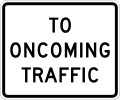


















![R3-5cP HOV 2+ (plaque)[b]](http://upload.wikimedia.org/wikipedia/commons/thumb/4/4b/MUTCD_R3-5cP.svg/120px-MUTCD_R3-5cP.svg.png)





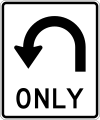









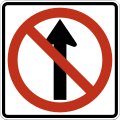



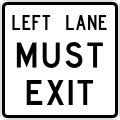
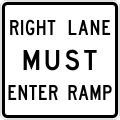

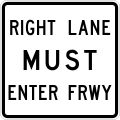




















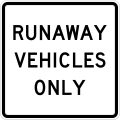













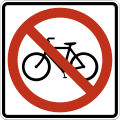


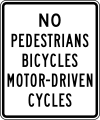
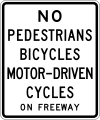









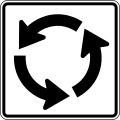



















































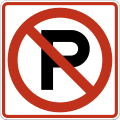












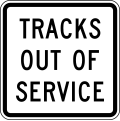


































































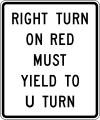














































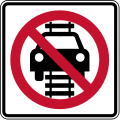

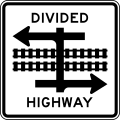





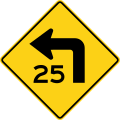



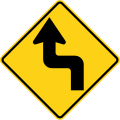
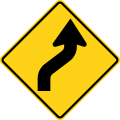



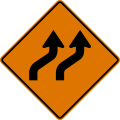
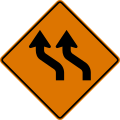









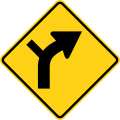





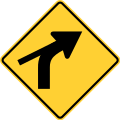




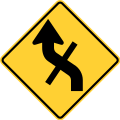






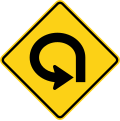


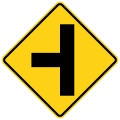














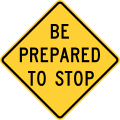

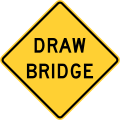




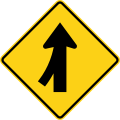



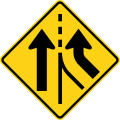








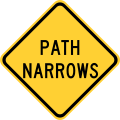





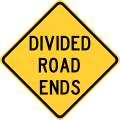

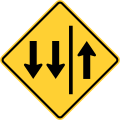



















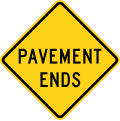

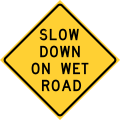





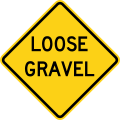

















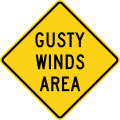









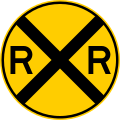




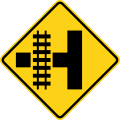

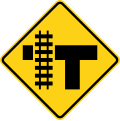
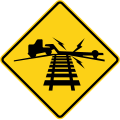















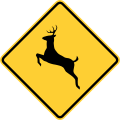
















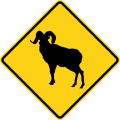

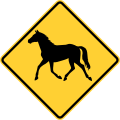















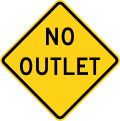

![W15-1 Playground[c]](http://upload.wikimedia.org/wikipedia/commons/thumb/c/cb/MUTCD_W15-1.svg/120px-MUTCD_W15-1.svg.png)
















